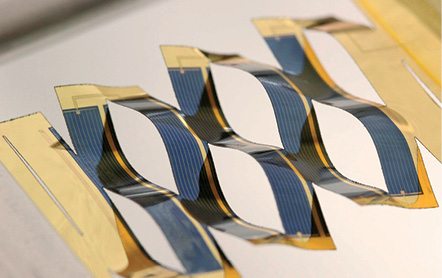Solar tech from Japanese paper-cutting art
While Origami, the Japanese paper-folding art is well-known, Kirigami is its lesser-known cousin that involves cutting and folding the paper. This interesting art recently motivated researchers at University of Michigan, USA, to come up with an exciting concept for solar panels.
What it can power. Aerospace applications, rooftop solar panels and more.
How it works. The new technology, detailed in Nature Communications, describes a lattice-like cell that can stretch like an accordion, allowing it to tilt along the sun’s trajectory and capture more energy. This deals with the perpetual problem of solar panels remaining stationary while the sun moves.
For low-cost installations on the rooftop, it is not possible to have complex tracking systems together with the panels, which means a lot of energy is lost every time the sun’s rays change direction. To solve this problem, Kirigami cells are made of flexible, thin-film gallium arsenide strips, cut in a simple, two-dimensional pattern. When the cells are stretched, a pattern pops out (like in a pop-up book), making these three-dimensional, improving the tracking radius to about 120°. This enables the film to collect 30 per cent more solar energy than conventional cells.


However, these benefits come at a larger footprint because the panels have to be around twice the size to provide room for the solar cells to stretch. There are many more such issues that need to be ironed out before this technology can be commercialised, but experts in the space still consider this as one of the quirkiest findings in recent times.
Clean tech inspired by the butterfly
Some people have very keen eyes. Guess what scientists at University of Exeter, UK, observed? A uniquely-angled V shape formed by the resting posture of a small species of butterfly called Cabbage White. This observation could pave the way for lighter, more efficient solar-energy-harvesting systems.
What it can power. Homes, digital signs, cars, wearables and other solar-powered things.
How it works. The wings of a butterfly catches everybody’s attention due to their beauty. But there is much more to it than meets the eye. Butterfly wings are complex. There are pairs of wings that link up during flight and overlap at rest, as well as special scale cells on their wings that show complicated morphologies and orientations. These scale cells are believed to confer optical properties to the whole wing.
The whole flight mechanism of the butterfly is, believe it or not, powered by solar energy! Butterflies bask in the sun to heat up their flight muscles before they can start fluttering. That is why you see more butterflies fluttering about on sunny days than on cloudy ones.
So when researchers noticed that Cabbage White started flying earlier than other species on a cloudy day, they started seeking what the butterfly’s specific advantage was. According to the team, this ability is thought to be due to the V-shape posture, known as reflectance basking, which they adopt on cloudy days to maximise the concentration of solar energy onto their thorax, which allows for flight. In simple terms, solar energy is concentrated as it bounces back and forth down the V-shape arrangement of the wings. The unique substructures of the wing also help solar energy to reach the flight muscles more quickly.
This whole structure can be reconstructed using special mirrors and photovoltaic cells. To prove the potential efficiency of such a system, scientists attached a Cabbage White’s wings to a conventional solar cell and achieved a 42 per cent increase in power output, increasing the power-to-weight ratio of the overall structure 17 folds. While it would be cruel to capture millions of Cabbage Whites to achieve this aim, the team believes it is certainly possible to build synthetic structures to achieve this purpose.
Indeed, scientists are looking everywhere for inspiration, so they can come up with more renewable and sustainable energy solutions, to power everything from homes and industries to personal devices and cars. If the quest does not gain momentum, we might be the first and last generation to have seen many of the devices around us.
Janani Gopalakrishnan Vikram is a technically-qualified freelance writer, editor and hands-on mom based in Chennai










